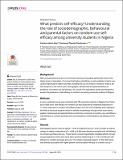What predicts self-efficacy? Understanding the role of sociodemographic, behavioural and parental factors on condom use self-efficacy among university students in Nigeria
Abstract
Background Risky sexual behaviours are not uncommon among young adults particularly those in the higher levels of education. It is known that higher self-efficacy could contribute to better sexual and reproductive health outcomes including the use of condoms. However, there is limited research on the role of socio-demographic, behavioural and parental factors as predictors of condom-use self-efficacy. As a result, this exploratory study was designed to assess the predictors of self-efficacy for condom use among university students in Nigeria Methods A cross-sectional survey was conducted with 755 university students in Nigeria from February to April 2018. Self-efficacy for condom use was assessed by combining responses to 11-items measures of condom self-efficacy drawn from the work of Barkley and colleagues. We fitted a structural equation model to identify the pathways through which socio-demographic, behavioural and parental factors predict two constructs of condom-use self-efficacy (self-efficacy for condom purchase and use and partner communication self-efficacy) in the sample. Results Demographic factors such as age (β = -0.29, p<0.05) and sex (β = 0.42, p<0.05), as well as ratings on religious importance (β = -0.08, p<0.05) were directly associated with self-efficacy for condom purchase and use. These factors showed significantly mediated effects through sexual experience which also had a direct positive relationship (β = 0.73, p<0.05) with self-efficacy for condom purchase and use. The receipt of parental support, on the other hand, was directly associated with higher partner communication efficacy for condom use (β = 0.07, p<0.05). We found no evidence that the level of partner communication efficacy was directly associated with any of the behavioural, demographic or parental factors. Conclusion The findings of this study affirm that sex, or age or having higher ratings on religious importance alone does not increases self-efficacy but also exposure to sexual activity through which these factors affect self-efficacy for condom purchase and use. These findings also highlight the need to address and strengthen condom use self-efficacy among young adults, particularly the sexually inexperienced, highly religious and young adults with limited support from their parent.
Citation
Ajayi , A I & Olamijuwon , E O 2019 , ' What predicts self-efficacy? Understanding the role of sociodemographic, behavioural and parental factors on condom use self-efficacy among university students in Nigeria ' , PLoS ONE , vol. 14 , no. 8 , e0221804 . https://doi.org/10.1371/journal.pone.0221804
Publication
PLoS ONE
Status
Peer reviewed
ISSN
1932-6203Type
Journal article
Collections
Items in the St Andrews Research Repository are protected by copyright, with all rights reserved, unless otherwise indicated.

